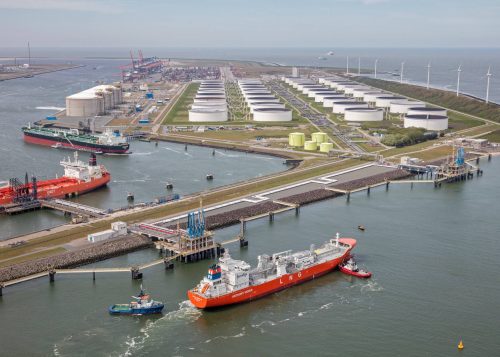Read in this article
- • The energy crisis and the war in Ukraine led Europe to focus on diversifying energy sources
- • Oil prices in the global market have risen to a level not seen since 2008
- • The increase in energy prices was the main factor for the rise in inflation rates in the United States
- • With the continuation of the Ukraine war, Russia will gradually face a serious challenge to its important role in the energy market
- • Russia will not be able to regain its share in the European energy market soon
- • Wind and solar energy recorded the highest growth in electricity production in the European Union
Since its outbreak on February 24 (2022), the war in Ukraine has thrown global energy markets into chaos and turmoil, prompting Saudi Arabia and OPEC+ to try to control the oil markets.
The energy crisis, as a result of the war in Ukraine, led Europe to focus on diversifying energy sources.
As a result, attention has been focused on the potential of European countries in the field of renewable energy, and at the same time, the focus has receded on climate change and sustainability.
The rise in oil prices was the first effect of the war in Ukraine, as prices on the world market rose, in the weeks and months following the Russian military offensive, to a level not seen since 2008.
The decision of the US government to stop importing Russian oil caused major unrest in the refining sector, and most of the oil imported from Russia was final refined products, or semi-processed oil.
The absence of Russian oil imports disrupted the supply of gasoline, and then diesel production during the period of high demand for this fuel, and this caused the highest weekly average prices for diesel and gasoline in the United States.
The increase in energy prices was the main factor in the rise in inflation rates in the United States, which reached its highest level in the past 40 years.
Repercussions of the continuation of the war
It is expected that if the war in Ukraine continues until next winter, energy security in Europe will face a challenge during that period. The old continent needs to increase investment in natural gas storage, and in building an integrated electricity and natural gas network.

Increasing the import of liquefied natural gas from Arab and African countries and increasing the role of renewable energies in the short term can reduce Europe’s dependence on Russian gas, and reach zero in the medium term.
The energy market is often affected by geopolitical events, and if the scope of the war in Ukraine expands, it will be a serious challenge for the energy market in 2023, as Russia does not want the Ukraine war to end soon.
Moscow will gradually face a serious challenge to its important role in the energy market, as the war in Ukraine continues.
The renewable energy boom
The Executive Director of the International Energy Agency, Fatih Birol, expressed his concern about the security of energy supplies and the low prices of renewable energy, which will become the main driver of the expected and unprecedented growth of this energy category in the next 5 years.
The International Energy Agency reports that global renewable energy capacity is set to double, to 5,650 gigawatts from 2,400 gigawatts by 2027.
The expected increase in renewable energy is now 30% higher than last year’s growth forecast, according to the International Energy Agency’s announcement.
Renewable energy sources are expected to account for more than 90% of global electricity development in the next 5 years, overtaking coal as the largest source of electricity generation by early 2025.
The war in Ukraine also means that China, India, Europe and the United States will account for most of the growth in renewables over the forecast period.
On the other hand, reducing Europe’s dependence on Russian natural gas and Russia’s focus on the Asian market was one of the results of Russia’s start of the war in Ukraine, and the European economy faced a challenge due to high oil and gas prices.
Increased investment in renewable energy in Europe is expected to accelerate the energy transition in the coming years.
Russia will not be able to regain its share in the European energy market soon, and if the war continues in Ukraine, the sanctions will continue, and other sanctions will be imposed on Russia.
The Russian economy has been affected by the sanctions, and if new sanctions are imposed on Russia, the Russian economy will face a serious challenge.
The growth of wind and solar energy

Wind and solar energy recorded the highest growth in electricity production in the European Union, reaching 19.1% compared to the previous year, surpassing natural gas for the first time. The share of wind and solar energy reached 22.3%, compared to 20% for gas.
In turn, nuclear energy ranked second after wind energy and solar energy, as it constituted 22% of the total energy supply, and hydroelectric energy accounted for 10%.
Some European countries used more coal to produce electricity, which caused air pollution, and the share of coal in the electricity generation sector in the European Union increased from 1.5% to 16% in 2022.
Meanwhile, countries such as Germany, Austria and Denmark have agreed to keep their coal-fired power plants ready for use.
liquefied natural gas
The increasing role of liquefied natural gas in energy security in Europe has led to an increase in the role of the Gulf countries in the production of liquefied natural gas, and the United Arab Emirates exported the first shipment of liquefied natural gas to Germany.
And America, as an ally of Europe, benefited from energy exports to help Europe’s energy security.
US LNG exports to Europe increased by 100% in 2022, with exports increasing to 841 shipments compared to 383 in the previous year, according to the US Energy Information Administration.
This represented 70% of total US LNG exports, placing the US ahead of Qatar as the world’s largest LNG exporter.
The volume of LNG heading to Europe marked an important shift in US energy exports, since since the spring of 2016, when exports began, most of the US LNG has gone to Asia.
If Russia had not waged war in Ukraine, it is likely that the largest share of US exports would still be heading east, and the crisis in Ukraine prompted countries to think about new ways of producing energy.

Despite the ambition of some countries to dispense with fossil fuels over the next few decades, serious steps were taken to wean consumers off carbon fuels in 2022.
For example, the largest step was seen in the United States, with Congress approving the Inflation Reduction Act.
Contrary to the name, the Inflation Reduction Act (IRA) is widely known as the “Climate Change Act”. It aims to put the United States on a path to reducing greenhouse gas emissions by about 40% by 2030.
This law is the largest climate investment in the history of the United States, but in general, renewable energy companies have been the biggest winners in this law.
OPEC + and the impact of high energy prices
This slight effect is due to the use of energy as an intermediate input. At the same time, higher energy costs may reduce the social surplus, causing slower economic growth.
This is because customers tend to buy fewer expensive items, such as real estate and vehicles, and companies reduce investment, as global energy costs increase.
Since carbon fuels mainly serve as intermediate inputs in the primary supply chain, increasing energy costs are driving up overhead costs around the world.
Since consumers will be more affected by higher costs, which leads to lower demand for goods, they should become the focus of policy makers’ attention.
On the other hand, the war in Ukraine was a major shock to global economies, leading to a $2.7 trillion drop in global GDP within 5 months of Russia’s attack.
A year after the war in Ukraine, the alliance of Saudi Arabia and Russia within the framework of OPEC + prevented the price from falling in the market, and we can expect to see a new trend in the oil market in the future.
However, demand in the oil market is increasing, and China, the world’s largest importer of crude oil, has announced sweeping changes in anti-COVID measures, which could promise an increase in demand.
It is difficult to imagine a stable world without Russian energy, however, if the predictions of JPMorgan, the International Energy Agency and others come true, we will have lower supplies and higher prices in the coming months, and OPEC will have to work to keep the markets in balance.
* Dr. Omod Shoukry, senior advisor on foreign policy and energy geopolitics, is the author of “US Energy Diplomacy in the Caspian Basin: Changing Trends Since 2001.”
*This article represents the opinion of the author, and does not necessarily reflect the opinion of the energy platform.
related topics..
Also read..

Leave a Reply